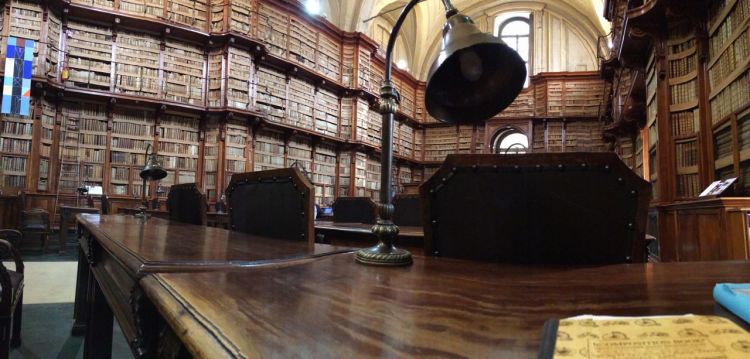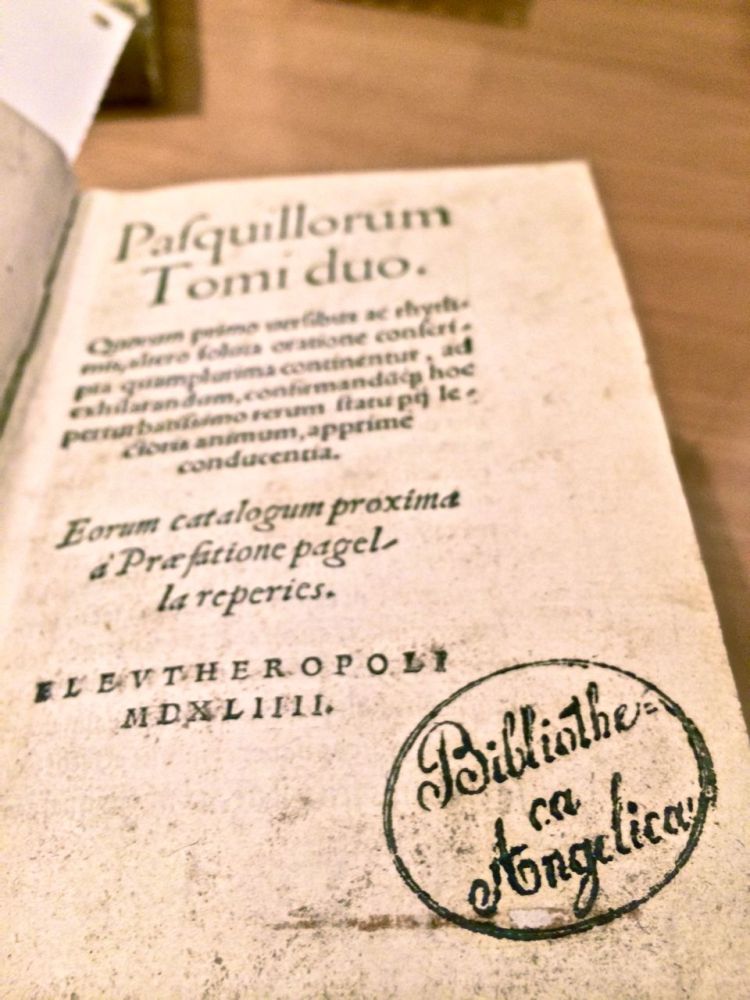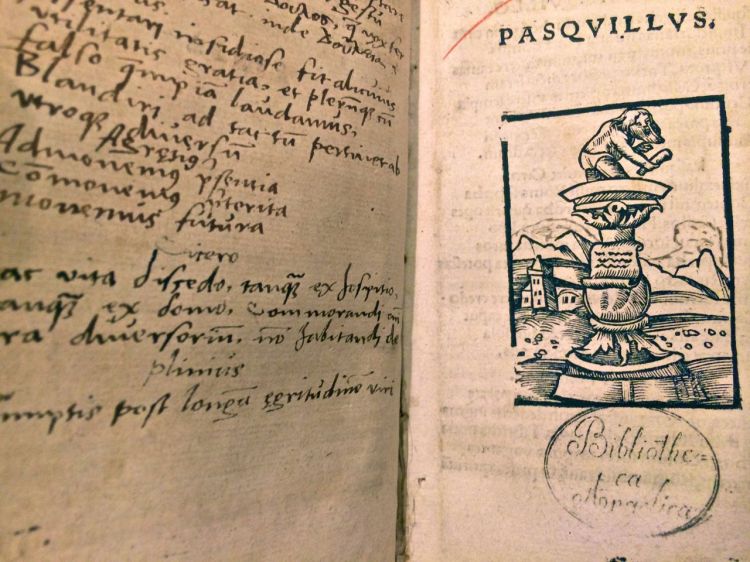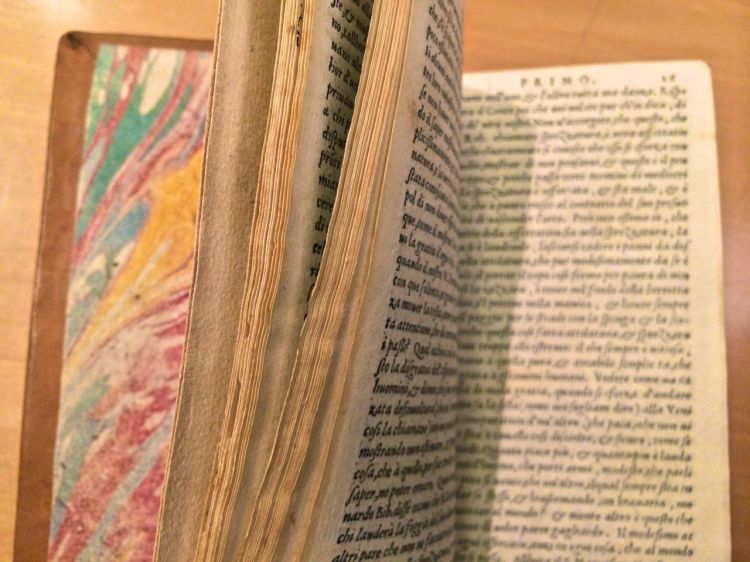As an English Literature major, and an avid lover of books, there is no paradise like that of sheltered haven of old books housed in a library with towering walls of ancient tomes and centuries old unopened pages. The other day I was in a book lover’s paradise. The name even seemed appropriate, Biblioteca Angelica, referring to the original collections owner Angelo, but to me it felt like a library of angels.

The Study Abroad Program I attend at the University of California Center in Rome has the ever fulfilling practice of site visits, wherein we the students get to go out into the wonders of Rome and have our lectures on site in many of the amazing places Rome has to offer up to those who seek its treasures. For one of my classes, Rome and Renaissance Literature, we had the pleasure of getting a mini little tour of Biblioteca Angelica and all of its centuries old wonders.
We were taken into the library and given a tour in Italian, which I was happy to discover I could understand almost everything she was saying. Our gracious host and guide through this wonderland of books, was kind enough to impart her extensive knowledge on the origins of the collection and its relation to the Church of St. Augustine, and the associated convent. The actual library itself, which is open to the public for study usage, and you know I will be back there in a heartbeat to study as soon as I can, was truly incredible. High ceilings, filled to the brim with walls of centuries old books, covering every inch of the walls, wrapped from top bottom and every corner of the building lined with beautiful tomes and books.

Standing in a library of old books is like standing in a sea of whispered words. Sinking into a warm abyss of aged pages, and words reaching out from paper to wrap and coil around your heart and mind like seaweed vines entwined around your being to bring you back to the books that sit silently, but softly calling your name. There is nothing more magical than a library filled with books spanning the great divide of time.
The library is from the 17th century, and many of it’s books are older than that. We were lucky enough to be brought down into another layer of the library where our host showed us some truly mazing treasures. She treated us to a handful of ancient books all from around the 1540’s that were just breath taking. There is something about a fragile binding, the browned pages thick and weighty to the touch, the gothic and italic scripts of printing press or a gifted hand that fills me with awe struck wonder. So much care went into these books, such dedication and time spent to create each one of these, and to think of how far they have come, and how long they have survived to end up in my hands at the very moment they were placed before me, today, this year, this life. It is amazing to think of the journeys that books take in their life time, not all of them are strong enough to weather the storm of time, but others are cared for or are lucky enough to be protected by the caring and cherishing embrace of a guardian. The stories that lie within the pages of these books, not just in the words on the page, but the stories and tales of time imbedded in the grain of the books, in every torn page or browned edge from the years that it lived and survived.

Looking carefully at each book placed before us, with eyes wide with wonder, the class beheld the books that beat back time to be with us in that very moment. 
We had a selection of books placed before us, but the most notable for us and our class were three works we specifically had and would be going over in class. The poems from Pasquino, taken from the talking statue and published so that the voice of stone could be read more universally, the poems from the counter poetic contest established by Goritz under the statue of St. Anne and the Raphael fresco of Isaiah in the book Coryciana, and finally, the one that took my breath away, a really old copy of the Book of the Courtier by Castiglione.
The Pasquillorum, pictured below was an amazing collection of poems posted on the statue of Pasquino. Pasquino is a statue near Piazza Navona that from the mid 15th century to the mid 16th century, people would use as a place to express their political, social, or any other sort of discontent in the form of poetry by attaching their writings to the base of the statue. The poetry would all be anonymous and take on the name of the statue as a sort of literary shield that allowed people to write anything and post it publicly without threat of punishment or censorship. The book we looked at was a collection of published poems that had been collected from the statue and put into a book. It was amazing to see the things we had been studying in our class come to life in these fragile old books. The words we had been reading on rough photocopied paper transformed into the elegant script of a 16th century book.
The other book that we got to see was an extremely old copy of the Book of the Courtier, or Il Libro del Cortigiano by Castiglione. The marble front cover, the old speckled pages, the ornate inside cover, and the script itself were all beautiful. To have read and studied this book, and now see it in its actual 16th century binding and creation was truly an experience. To feel its pages, the slight rise of the printed inky black words, the torn corners, or the fragile binding that took this book beyond literature into a historical work of art in preservation.
I was so grateful for that experience, and it was definitely my favorite site visit of the semester thus far, but then again as an English major I am always biased when it comes to books, especially really old ones. We left the library in a state of awe and contemplation, pulled back from the depths of that silent, warm worldly embrace back out into the noisy bustling world of Rome, like a person being born again into a strange and unnatural world. I almost turned around and went right back into the silent haven of books, but I had to keep going. To let all of the experience sink in I went and got coffee at the well known Sant’Eurstachio Cafe, where I sat outside on the bustling streets of the piazza, watching the world move on around me. Thinking about how different the world before my eyes was than the world inside of the books we had just looked at. And strangely enough, in many odd ways, the worlds, though vast different, didn’t actually seem too far from one another. I could see the lining, the black words in the outlines of every person that walked by, etched into the words that came out of all of their mouths, were the traces of the same words used in those books. It was an interesting time to sit and watch the world, wondering about all that had changed, but also all that had remained the same. 
Tags: ancient, biblioteca angelica, book of the courtier, books, italy, library, manuscript, pasquinades, rome






